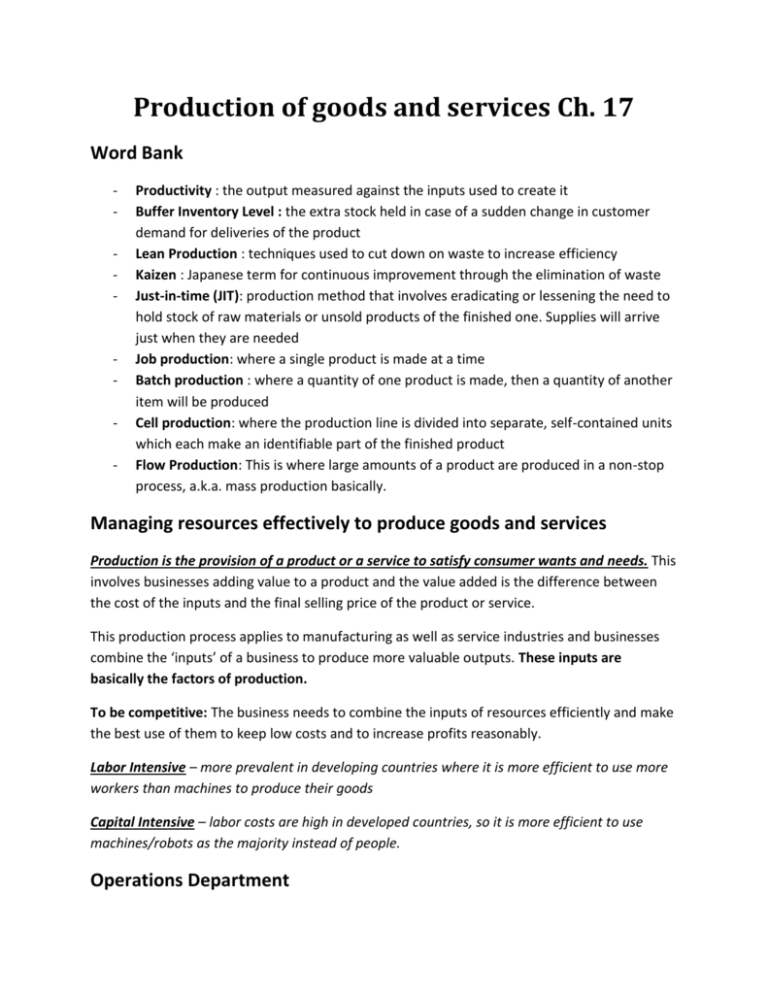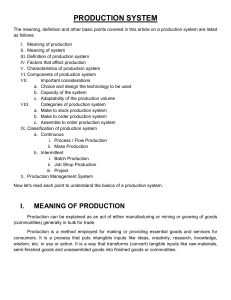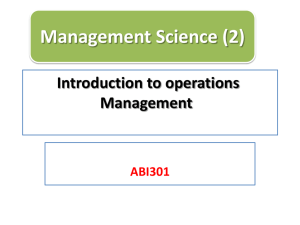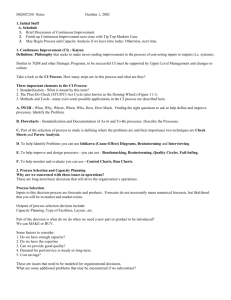Productivity
advertisement

Production of goods and services Ch. 17 Word Bank - - Productivity : the output measured against the inputs used to create it Buffer Inventory Level : the extra stock held in case of a sudden change in customer demand for deliveries of the product Lean Production : techniques used to cut down on waste to increase efficiency Kaizen : Japanese term for continuous improvement through the elimination of waste Just-in-time (JIT): production method that involves eradicating or lessening the need to hold stock of raw materials or unsold products of the finished one. Supplies will arrive just when they are needed Job production: where a single product is made at a time Batch production : where a quantity of one product is made, then a quantity of another item will be produced Cell production: where the production line is divided into separate, self-contained units which each make an identifiable part of the finished product Flow Production: This is where large amounts of a product are produced in a non-stop process, a.k.a. mass production basically. Managing resources effectively to produce goods and services Production is the provision of a product or a service to satisfy consumer wants and needs. This involves businesses adding value to a product and the value added is the difference between the cost of the inputs and the final selling price of the product or service. This production process applies to manufacturing as well as service industries and businesses combine the ‘inputs’ of a business to produce more valuable outputs. These inputs are basically the factors of production. To be competitive: The business needs to combine the inputs of resources efficiently and make the best use of them to keep low costs and to increase profits reasonably. Labor Intensive – more prevalent in developing countries where it is more efficient to use more workers than machines to produce their goods Capital Intensive – labor costs are high in developed countries, so it is more efficient to use machines/robots as the majority instead of people. Operations Department Their role in business is to take inputs and change them into outputs for customer use. Inputs are either physical goods or services. Operations Manager – responsible for making sure raw materials are provided and made into finished goods or services. The sections of the operations department changes depending on what the business produces/offers. A typical manufacturing business will have: - - A factory manager – takes care of the quality & quantity of products coming off the production line, and also responsible for the maintenance of the production line & other repairs. A purchasing manager – provides the materials, components and equipment required A research and development manager – responsible for the design and testing of new production products and processes. Very important. Productivity Productivity is how a business can measure its efficiency. Productivity = quantity of output / quantity of inputs An example of what a business will use this equation for is to measure the productivity of one of its factors of production, e.g. labor. Labor productivity = output (over a given period of time) / # of employees Productivity can either mean using fewer inputs to produce the same output or using the same inputs to produce a much greater output. Efficiency increases = output increases = cost of producing the product decreases Remember: Different levels of success at being productively efficient account for the difference between a firm’s ability to be competitive remain trading and being able to generate profits. Ways to improve productivity: - Improving the layout of the machines in a factory to reduce wasted time and therefore increase efficiency Improving labor skills by training workers so they have more productive techniques of working - Introducing automation Other ways - Improve quality control/assurance reduces waste Use machines instead of people to do jobs (automation) Improve employee motivation Introduce new technology Train staff to be more efficient Improve inventory control Benefits: - Increased output relative to the inputs required Lower costs per unit (avg cost) Fewer workers may be needed, possibly leading to lower wage costs Higher wages for workers increases motivation Why businesses hold inventories (stock) Reasons why a business may run out of stock: - Late delivery Higher demand than usual Examples of inventories: - Raw materials Components Partly finished goods Finished products ready for delivery (sometimes) spare parts for machinery in case of breakdowns (Re-order point) when inventories get to this point, they need to be re-ordered to bring back maximum inventory level again. They need to re-order before the inventories get too low to allot for time that will be spent in delivering the goods. The inventory needs to not be too high since it will cost a lot of money to maintain which could be used otherwise. Lean Production This covers a variety of techniques used by businesses to cut down on waste and increase efficiency. Seven types of waste that occur in production: - Overproduction: producing goods before they have been ordered. This creates high storage costs and can possibly damage the goods while they are in storage. Waiting : when goods are not moving or being processed in any way then waste is occurring Transportation: moving goods around unnecessarily causes waste and is not adding value to the product. It can be further damaged. Unnecessary inventory: if there is too much inventory then this takes up space, might obstruct production and cost money. Motion: any actions, including bending or stretching movements of the body of the employee wastes time. It’s also a possible health and safety risk. Over-processing: complex machinery doing simple tasks is wasteful. Some activities in producing the goods may not be necessary if the design of the product is poor. Defects: time needing to be used to fix these problems is wasteful overall. Benefits of lean production Costs are saved by: - Less storage space required Quicker production No need to repair / replace defected products Better use of equipment Cutting out unnecessary processes Less money tied to inventory Improve health and safety leading to less time off work due to injury Lean production might use these methods: - Kaizen Just in time delivery control Cell production Kaizen ‘Continuous improvement’ in Japanese, its focus is on the elimination of waste. Example of using this: - Small groups of workers group together to discuss problems and possible solutions. - Eliminates waste by getting rid of piles of inventory/reducing time taken for workers to walk between jobs to get rid of excess movement Re-organizing the factory machinery alignment to improve movement Advantages: - Increased productivity Reduced amount of space needed for the production process Work-in-progress is reduced Improved layout of the factory floor creates the possibility for the jobs to be combined which frees up employees to carry out some other job in the factory. Just in time inventory control This focuses on eliminating the need to hold inventories. - The costs for holding the inventory are all reduced since there isn’t a need for them. Warehouse space becomes unnecessary The finished product is sold quicker, so money comes back faster to the business increasing cash flow. Cell Production The production line is split into separate, self-contained units which each make an identifiable part of the finished product instead of having a flow or mass production line. This method improves the morale of the employees and makes them work harder and become more efficient. This also makes them feel more valued and decreases chances of them from striking out or causing a disruption. Methods of production - Job production Batch production Flow production Job production This is where a single product is made at a time, e.g. a cake is ordered and a single employee makes it. Each order is different, and may or may not be repeated. Another e.x. is specialist machinery. This is where manufacturers who manufacture a machine for another business do it to meet a particular specification. Examples: bridges, ships, made-to-measure suits, cinema films, or individual computer programs that perform specialized tasks. Adv. - Suitable for one off products/personal services Products meet exact requirements of the customer. Workers have more varied jobs Flexible and often used for high-quality goods and services = higher price can be charged Disadv. - Skilled labor is needed Costs are higher = labor intensive Production takes a long time Products are specially made to order so errors are expensive to fix Materials may have to be specially purchased leading to higher costs Batch production Products are made in blocks or batches. A certain number of another product is made, and so on. E.g. making a group of a certain types of cakes like chocolate and then making another type for sale too. Or several houses built together following a similar design, furniture production and famously, clothing designs. Adv. - Flexible way of working and production can easily be changed Gives variety to workers’ jobs Allows more variety to products which would otherwise be identical = increases consumer choice Production may not be affected to any great extent if machinery breaks down Disadv. - Can be expensive since semi/finished products will need moving about Machines have to be reset between production batches which means there is a delay in production and output is lost Warehouse space is costly Flow Production This is where large quantities of a product are produced in a continuous process. A.k.a. mass production. E.g.: cars, cameras, televisions, packaged foods and drinks. Any mass produced standardized product which is sold to a mass market is most likely produced in this way. Adv. - High output of standardized product Costs are kept low and therefore prices are also lower Easy for capital intensive production methods to be used = reducing labor costs and increasing efficiency Capital intensive methods allow workers to specialize in tasks which means little training is needed due to unskilled workers Might benefit from economy of scale in purchasing Low average costs = low prices = high sales Automated production lines can operate 24hrs a day Goods are produced quickly and cheaply No need to move goods from one part of the factory to another like batch production = time saved Disadv. - Boring system = low job satisfaction = lack of motivation High storage requirements – cost of inventories of raw materials/components and finished products can be very high Capital costs of setting up the production line can be very high If one machine breaks down the whole production line will have to be paused. Factors affecting which method of production to use - - Nature of the product: a unique/individual service is required = job production. If it can be mass produced = flow production. Size of the market: demand is high / more products can be sold but not in large quantities = batch production. International market? = flow production. Nature of demand: large and steady demand for the product? (Soap powder e.g.) then it’s economic to set up a production line by = flow production. Less frequent demand?(furniture) then = job or batch production fits. Size of the business: small business and capital? Job or batch production most likely. Only large businesses can really afford to maintain a flow production method How technology has changed production methods: Technological advances have allowed the mechanization and automation of production methods in many industries. The car industry is almost entirely automated. Robotics, automation, CAD/CAM keeps businesses ahead of the competition, keeps costs falling, reduces prices and improves products manufactured. - - - - - Automation – where equipment used in the factory is controlled by a computer to carry out mechanical processes like paint spraying on a car assembly line. The production line will consist mainly of machines and only a few people will be needed to ensure success. Mechanization – production is done by machines but operated by people. E.x. printing press. Robots are machines that are programmed to do tasks that are useful for unpleasant, dangerous and difficult jobs. They are quick, accurate and work non-stop 24 hours a day. CAD (computer aided design) – computer software that draws items being designed quickly and allows them to be rotated to see the item from all sides instead of having to draw it several times. It can restyle old/design new products. It is useful for technical drawings. CAM (computer aided manufacture) – computers monitor the production process and control machines or robots on the factory floor. E.x. car plant computers control the robots that spot-weld the car body together or the robots that spray paint the car. CIM (computer integrated manufacturing) – total integration of CAD and CAM. They are directly linked together. Technology also improved productivity in shops with electronic payment methods and scanners at tills. - - Epos (electronic point of sale) – where the barcode is scanned when you pay, the information is displayed on a screen then printed on a receipt. The inventory record is also updated to show one item has been and sold and if they stock has reached the reorder point then more inventory is automatically re-ordered. EFTPOS (electronic funds and transfer at point of sale) – this is where the electronic cash register is connected to the retailers’ main computer and also to banks over a wide area computer network. The card is swiped at the till and bank information is automatically read from the card. Money is directly debited from the customer’s account after they have signed for the debit or entered their pin. A receipt is printed as confirmation that the payment has been done. The advantages of new technology - Increased productivity due to new methods of production Increased job satisfaction to stimulate workers since boring jobs are done by machines Types of jobs are changed as more skilled workers are needed to use the new technology. Better quality control on products = better quality products More accurate consumer demand results from computers being used to monitor inventory levels Quicker communication and reduced paperwork, owing to computers, lead to increased profitability. The information that is available to managers is much greater and this results in faster and better decision making New products are introduced as new methods of production are introduced. The market tastes changed with the consumer. The disadvantages of new technology - Unemployment rises as machinery/robots replace humans Expensive to invest in. this increases the risks as large quantities of products need to be sold to cover the cost of purchasing the equipment. Employees are unhappy with the changes in their work practices when new technology is introduced. New technology is introduced all the time so it will need to be updated to keep the business competitive. ------------------------------------------------------END-----------------------------------------------------






